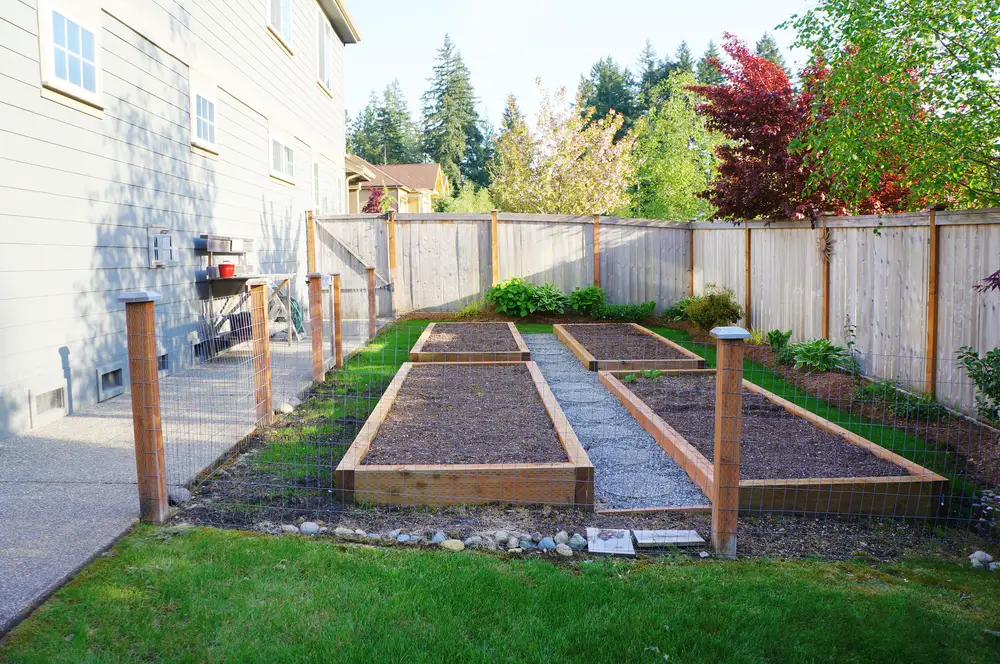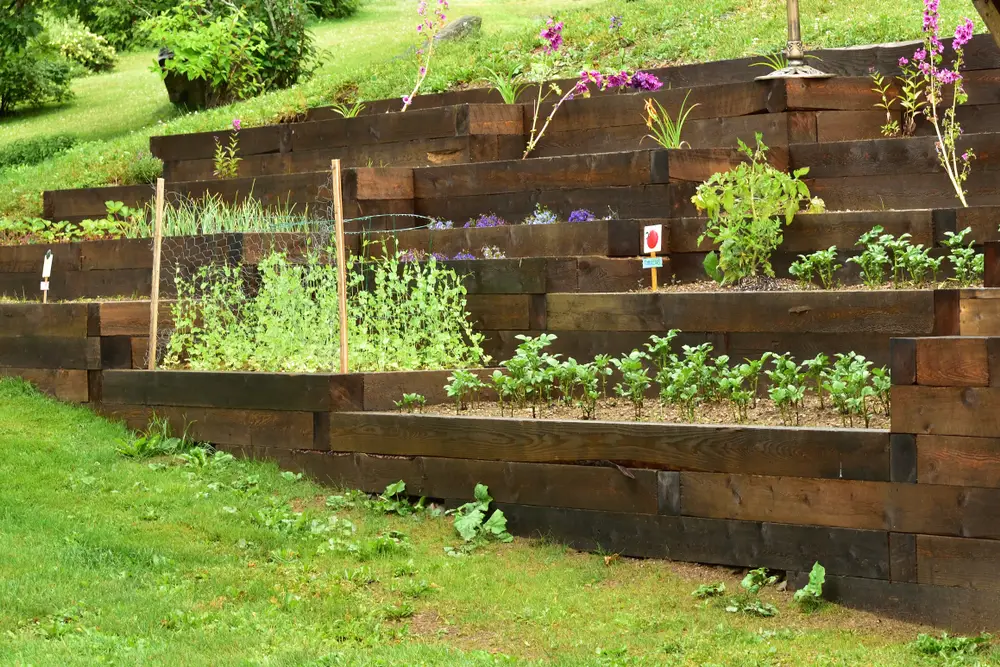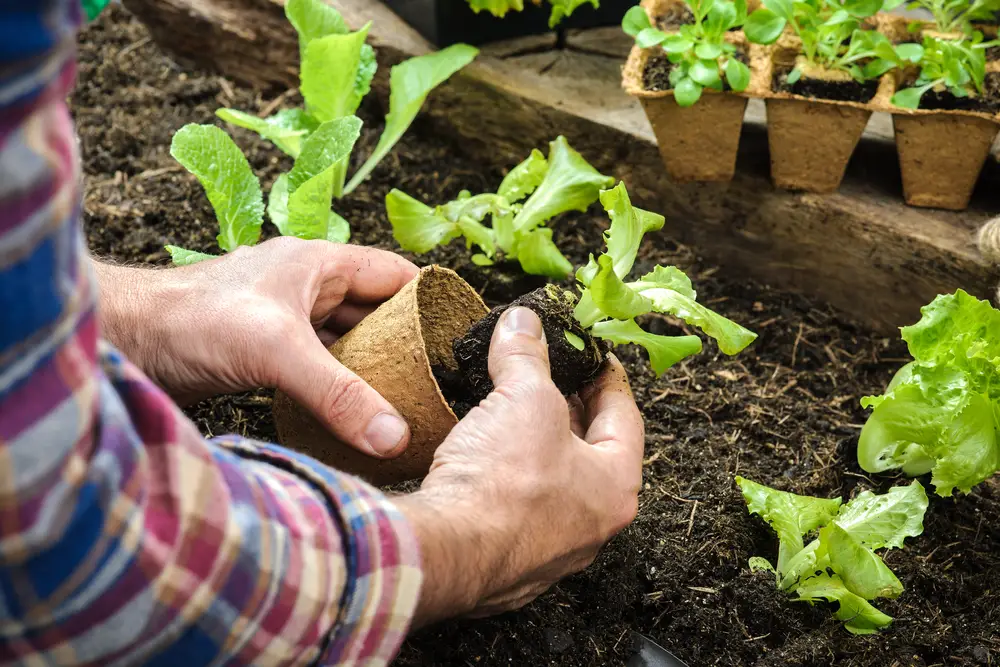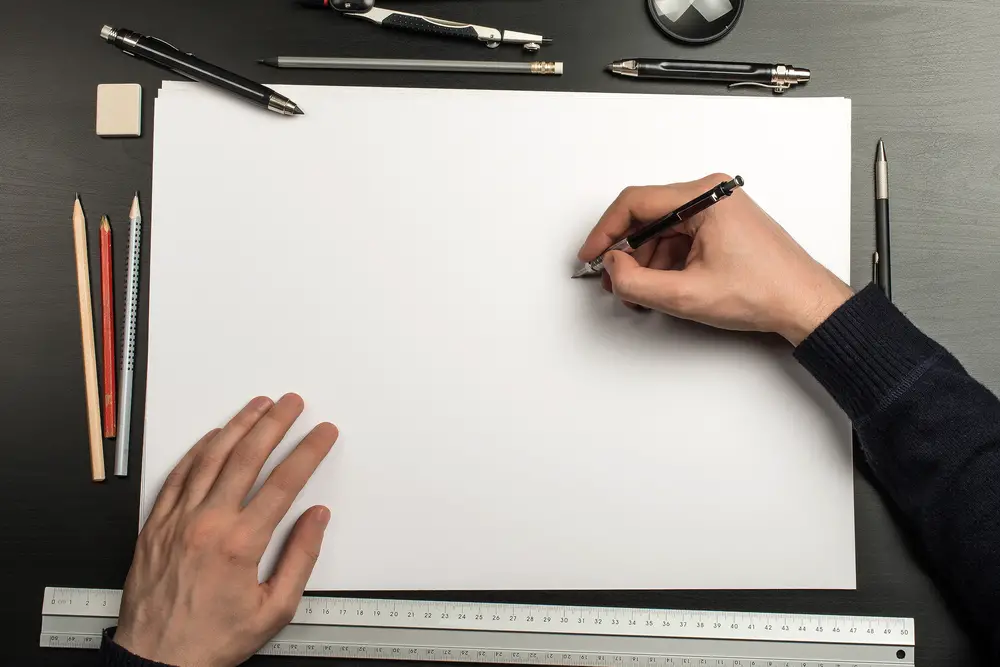Summary
Take the following steps to design the perfect vegetable garden layout:
- Gather needed supplies
- Long tape measure
- Graph paper
- Pencil and eraser
- Ruler
- Choose a location based on:
- Sun
- Soil
- Drainage
- How protected the site is from wind
- Water source
- Ease of access
- Design the layout with considerations for the following:
- Size
- Rows or blocks
- Orient to the sun
- Pathways
- Raised beds
- Growing in small spaces with grow towers, pallets, or containers and hanging baskets
- Fencing
- Choose what to grow where with considerations for the following:
- Plant height
- Water requirements
- Companion plants
- Succession planting
- Winter gardening
- Future crop rotation
- Draw your design
I was so excited the first time I decided to grow vegetables. I bought a bunch of starter plants at the garden center in the spring and tried to find space to plant them all. Of course, I’d bought too many, and the vegetable bed ended up way too crowded by the time everything grew in.
Some plants got diseased. Others were shaded out and didn’t produce well. Come harvest time, I couldn’t get at the plants properly to pick what I wanted without crushing other plants in the process.
In the following years, I made a plan and designed my vegetable garden long before it was time to start seeds or buy transplants. It gave me something to think about while I was waiting impatiently for the growing season to arrive.
Getting the right design for a vegetable garden layout isn’t complicated or difficult. Taking the time to plan what you want to grow and then draw a design on paper will mean better success, and it can save you from overspending on plants you won’t have room for.
The following steps take you through the process of collecting the information you’ll need and then how to draw your vegetable garden design.
1 – Gather Needed Supplies

- Long tape measure
- Graph paper
- Pencil and eraser
- Ruler
Once you’ve decided where to locate your vegetable garden, you’ll need to measure the dimensions. You need to know what space you have so you can figure out how many plants you’ll have room for.
You’ll use the rest of the tools to design a map of your vegetable garden layout and where you’ll plant everything.
2 – Choose A Location

When choosing where to put your vegetable garden, you’ll need to think about the sun, soil, and drainage in different parts of your backyard. All these factors are important to ensure healthy plant growth.
Sun
Most vegetables need at least 6-8 hours of direct sunlight daily to grow well and produce a good crop. A few (mostly leafy greens like lettuce, kale, and spinach) can tolerate a little shade.
In regions with extremely hot growing seasons, you may want to choose a site that just gets morning sun and is shaded by about 2:00 PM. You could also choose a site that gets sun before noon and then again later in the afternoon (i.e., it is shaded only during the peak heat of the day).
Soil
Vegetables like soil that’s well-draining, not too dense, and has sufficient organic matter and nutrient content. The soil feeds your plants, so it’s important to ensure it will do the job.
Choose a spot in your garden where the soil isn’t too rocky and hasn’t been compacted by heavy machinery or lots of foot traffic.
Drainage
Vegetables like well-draining soil. Soil that stays too wet for too long will rot root vegetables and kill the roots of others. Avoid spots in your garden that sit wet long after a heavy rain.
If all the sunny spots in your garden have poor drainage, you may need to plant in mounded rows or raised beds so your vegetables can grow above the water-logged soil.
Choose A Site Protected From Wind
Plants dry out faster in windy conditions, just like our skin. Also, wind can damage stalks on taller vegetables or vining varieties grown on supports.
Choose a location that’s protected from heavy winds.
Be careful about planting right up against a solid fence in wind-prone regions. Wind can blow up and over a fence and down the other side with greater force than on the upwind side. So, instead of placing your vegetable beds up against a solid fence, put them a few feet away.
Fences with slats or openings that let some air flow through will not develop these wind-force pockets.
Water Source
It may seem obvious, but choose a site with easy access to a water source. Think about how you’ll water your vegetable garden, whether with a handheld hose, soaker hose, or drip irrigation, and choose a location as close as possible to the source. You don’t want to drag hoses across the rest of your garden every time the vegetables need watering, which could be twice a week or more in hot weather.
On the other hand, you may decide to install a permanent efficient drip-irrigation system, which saves the hassle of hoses altogether. You’ll save money on installation costs if your vegetable garden is closer to a water source where the system will be connected.
Ease Of Access
If you have a choice of locations, plant your vegetable garden as close to your house as possible. If it’s not too far, you’ll be more motivated to pick something fresh for a meal.
3 – Design The Layout

Size Considerations
If this is your first vegetable garden, it’s best to start small. This would be a bed about 8 feet (2.5 meters) x 10 feet (3 meters). This is manageable while still being big enough to give you plenty of room to grow lots of different vegetables.
Rows Or Blocks
The traditional method for planting a vegetable garden is in rows, but this can take up a lot of space.
If you have a smaller backyard and limited space for a vegetable garden, you might want to plan your vegetable garden in blocks instead.
In blocks, you’ll plant vegetables closer together, making more efficient use of limited space and increasing your harvest.
Each block shouldn’t be wider than 4 feet (1.22 meters) so you can reach the middle from either side.
Orient To The Sun
If you plant in rows, it’s not that important whether you run them north-south or east-west. The important thing is to plant the taller plants (and those growing on a trellis) at the north end so they don’t shade out the plants on the southern edge of your vegetable garden.
Pathways
You’ll need to be able to reach every spot in your vegetable beds to weed them and harvest the crops. A good rule of thumb for reach is about 2 feet (0.61 meters) for most of us.
So, if a bed is wider than 4 feet (1.22 meters), you’ll need to include pathways in your design so you can comfortably reach the center from either side without walking on your plantings.
Raised Beds
Planting directly into the garden soil (level ground) is generally the preferred choice if you have good quality soil with good drainage.
If you have poor-quality soil or poor drainage or have mobility issues that make gardening at ground level difficult, then raised beds are an excellent gardening problem-solver.
Raised beds can also be planted earlier in the season because the soil in raised beds warms up more quickly in the spring than the surrounding garden soil.
Also, in the late fall, when early frosts are a risk, a raised bed can offer some protection because cold air will settle on the lower ground surrounding them.
You can build raised beds using a variety of materials, from wood to bricks or stone. You can design them as another architectural feature to tie in with the overall design of your backyard.
Growing In Small Spaces
You can always go vertical if you have limited space for a vegetable garden.
There are many vegetables, such as pole beans and cucumbers, whose long vines can be grown on tall supports such as trellises, arbors, or tripods. These structures can increase the harvest on a small patch of space and add some visual interest to your garden.
Smaller plants such as leafy greens, radishes, or bush beans don’t need much space and can be grown in vertical planters.
Grow Towers
Basically, these are made up of a series of small containers stacked vertically to create lots of growing room on a small footprint. There are many different designs on the market, or you can make your own. You can put them in your vegetable garden or even on a deck or patio.
Pallets
Some gardeners convert old shipping pallets into vertical growing systems attached to a wall. The spaces between the pallet slats become planting rows for vegetables that don’t need much space or soil.
Containers And Hanging Baskets
If you don’t have a lot of room in your backyard, you can always grow vegetables in a few containers and hanging baskets on the deck or patio.
You can grow just about anything in containers as long as you match the size of the plant with the size of the container. Vegetable seed packets will give you information on how big each variety will get, and some will even be labeled as good choices for containers.
Fencing
If you have deer and rabbits visiting your backyard, you’ll want to plan for some sort of fencing to keep them out of your vegetable garden. All it takes is one nighttime visit for them to munch down an entire crop.
4 – Choose What To Grow Where

Once you’ve figured out the best location for your vegetable garden, choosing what varieties to grow will need to match your garden conditions if you want a successful harvest.
Where you plant the varieties in relation to each other in your vegetable garden will also be important.
Here are some things to consider.
Plant Height
Once you’ve figured out how the sun moves across your chosen location throughout the day, be sure to plant the taller varieties where they won’t shade out other shorter varieties that like the same amount of sun.
You can also plant taller varieties strategically to cast shade on shorter varieties that like a bit of shade. For example, if you live in a hotter region with intense mid-day sun, plant taller sun-loving plants where they’ll provide shade to shorter plants that may not like as much heat.
Water Requirements
Put varieties with similar watering needs together. For example, Swiss chard or beans can tolerate less water than tomatoes or cucumbers.
Companion Plants
You’ll want to consider keeping space for a few plants other than vegetables. These will be things like flowering plants that attract pollinators and predatory insects that will eat pests like aphids on your vegetables.
You can plant them around the edges of your vegetable garden or amongst the vegetables.
Succession Planting
With a little planning, you can use the same spot in your garden to grow more than one variety of vegetable in a growing season by planting one variety after another has finished.
For example, you can plant radishes while the soil is still cool and harvest them 4 to 6 weeks later. Once you’ve harvested the radishes, you can use the spot to transplant your tomatoes or put in green beans. Once that crop is done, you can take out the plants and start something else for winter harvest.
How many successive plantings you can do in the same spot will depend on your growing zone, the length of your growing season, and what plants you choose to grow.
Winter Gardening
If you live in a region where winter temperatures don’t go much below freezing, you can plant certain vegetables in mid to late summer and harvest them well after the summer growing season is over. The vegetables you choose should be ones that can tolerate light frost, such as kale and root vegetables.
Planting strategies and crop choices will vary depending on your growing zone.
Future Crop Rotation
Crop rotation means changing the planting spot of a specific vegetable (or family of vegetables) each growing season. It’s important not to plant the same vegetable (or anything in the same family) in the same spot year after year because this can cause a build-up of damaging diseases or pests in the soil.
Plan your vegetable garden with crop rotation in mind. Keep a record of what varieties you grow where each year, and plan your plantings so you can rotate crops on a 3- to 4-year cycle.
5 – Draw Your Design

Once you’ve decided on a location and what vegetables you’d like to grow, you’ll need to map out where you want to put everything. The best way to do this is to make a drawing.
Making a drawing is easy to do. It’ll help you figure out how many plants you actually have room for and where to put them. This’ll help reign in your pre-season enthusiasm (and save you money) when purchasing transplants or starting seeds indoors!
Before starting your drawing, measure (or make a note of) the length and width of your chosen location.
Then, make a list of the vegetables you want to grow. For each variety, make a note of the following details (a lot of these can be found on a seed packet):
- What family is it in
- How much sun does it like
- What are its watering needs
- How much space will it need (“Spacing” in a plant description)
- How tall will they grow
- Which ones will you grow on a trellis or other tall support
- Days to maturity
You’ll be using graph paper for your drawing, so you’ll be able to draw your design “to scale.” This is important so you know exactly how much space you’ll have to work with and how many plants will fit into it.
First, draw in your planting blocks or rows, and then add your pathways.
Then add the tall plants across the north end of the beds, and where you’ll put tall trellises, etc., to support climbing varieties.
As you add plants to the drawing, remember their spacing and how tall they’ll get.
Be sure to note which family each plant is in, and don’t put different varieties of the same family beside each other.


